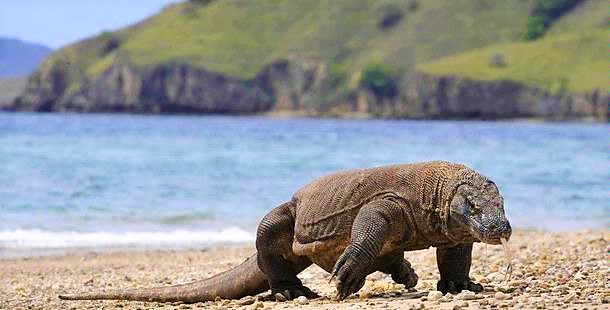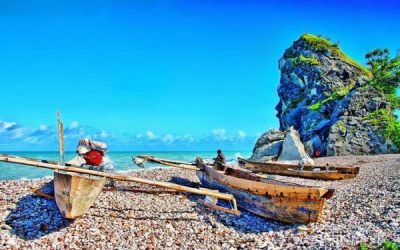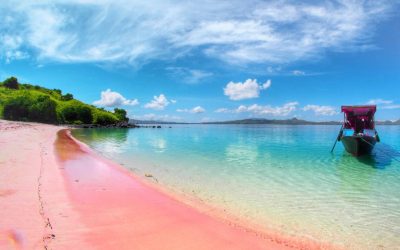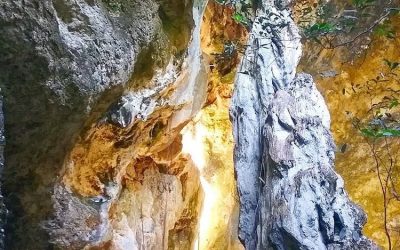Home / Batik Regions – Eastern Indonesia – East Nusa Tenggara / Komodo National Park – UNESCO World Heritage Site
Natural Destination
Komodo National Park – UNESCO World Heritage Site
Komodo National Park (photo: @Mardhana Ksatrya/Kompasiana)
Komodo National Park – UNESCO World Heritage Sites
Komodo National Park is located in Komodo Island, which is situated near the main port Labuan Bajo, East Nusa Tenggara. It was inscribed as UNESCO World Heritage Site in 1991 due to the presence of the world’s protected Komodo dragon. This park has some major attractions: lush reefs, manta point, pink beach and Komodo dragons park. Komodo dragons are carnivorous reptiles whose saliva is poisonous for humans. Watch out for the presence of those big lizards and pay thorough attention to the direction provided by the local guides when you are at Komodo site. Another stunning tourist attraction is Padar island, which is located next to Komodo Island. By taking the boat from Komodo island and hiking for 20-30 minutes to the top of Padar island, you will see an outstanding view of the island, along with its 3 colour beaches: white, pink and black. In addition, this region offers a great mixture of natural and cultural attractions with good tourism facilities as well. Do you want to experience earth’s extraordinary natural wonder? Visit Komodo Islands, Indonesia!
Natural Tourism Destination
Komodo National Park at Labuan Bajo Region
Tourist Attractions in East Nusa Tenggara
Kolbano Beach
Kolbano beach is one of Indonesia’s unique beaches whose sands consist of
Pantai Merah Muda – Pink Beach
Have you ever been to a beach were the sand is pink?
Batu Cermin Cave in Labuan Bajo
This place was once an underwater cave. It is named after the light that shines through
East Nusa Tenggara
Batik Motifs
Kuda Kupang
Horses symbolize wealth. It contains noble values of virtuous characters that bring
Teguh Bersatu
This batik motif shows the strength of the people of Kupang. It also represents a sense of
Discover
Indonesian
Batik
Motifs
Wakatobi
It symbolizes the coastal beauty of the Wakatobi island and the symbol of Patra symbolizes
Sekar Jati
Sekar means flower and Jati refers to teak trees that symbolizes a strong mental character that
Lipaq Sabe
Lipaq Saqbe contains a simple geometric classical motif with various flower decorations. This textile is
Kaharingan
The Kaharingan or ‘tree of life’ based on the Dayak tribes’ belief system. This tree symbolizes
Kasih Tak Sampai
‘Kasih Tak Sampai’ is an idiom in the Indonesian language which refers to
Teguh Bersatu
This batik motif shows the strength of the people of Kupang. It also represents a sense of
Pucuk Rebung Riau
Pucuk Rebung symbolizes heart determination in achieving goals, good luck, and
Singayaksa
The Singayaksa motif comes from the name of a place where Sultan Hasanuddin used to
Sandeq
Sandeq Boat is a symbol of the maritime importance of the West Sulawesi region. The greatness of
Gonggong Beruntun
This motif illustrates that a person should maintain a positive attitude and
Karawo Pinang
Pinang refers to the Palm areca tree. This motif is considered as the original
Biji Kopi
The coffee seeds motif illustrates the pride of local coffee specialities in
Tangerang Herang
Tangerang Herang motif is a symbol of Tangerang city. The Tangerang Herang batik motif consists of
Sero Tangga
The Sero Tangga illustrates an endearing feeling and sacrifices of a person to fulfil
Burung Bidadari
Bidadari birds are endemic birds in Halmahera. This motif represents an
Manguni Minahasa
Manguni is identified as the symbol of the Minahasa people. Manguni is known as a
Tenun Bima
The motifs are adopted from Bima woven textile. This pattern has received a great
Jumputan Bintang
The word Jumputan means the tie-dye technique, while the word “Bintang” refers to
Bale Lumbu
This motif signifies the welfare of the ancient Sasak society. Bale also symbolizes the
Kuda Kupang
Horses symbolize wealth. It contains noble values of virtuous characters that bring
Paqbarre Allo
The word “Barre” means round and “Allo” means the sunlight. This motif is interpreted as
Kawung
The Kawung motif was created by Sultan Agung Hanyokrokusumo (1593 – 1645) as a symbolic gift for
Dayak Taghol
Dayak Taghol has a distinctive style of four curved lines and small dots. This motif represents
Gentala Arasy
Built as high as 80 meters, the tower also highlights the historical side of
Gurdo Solo
Gurdo or garuda bird is the mount of the Indian god Vishnu. As the Sun Bird,
Gajah Way Kambas
The motif illustrates the Lampung’s natural reserve, the Way Kambas. it also symbolizes
Bultiya
The word ‘Bultiya’ is an acronym of the three major tribes in North Kalimantan, namely
Lok Baintan Floating Market
As you can imagine, the most authentic thing is that you can buy things and even
Cengkeh
The clove flower motif is the main commodity of the Tolitoli Regency. This motif represents
Wirasat
Wirasat or divine inspiration is a gift from God. This inspiration is symbolized by
Enggang Dayak
Local people beliefs that hornbills are an incarnation of the Commander of the Birds. It has supernatural
Sido Mulyo
Sidomulyo is one of the classical motifs, which is specifically used for the bride’s costume in
Bekantan Pakis
This motif represents Pakis Haji (Polystichum setiferum), an endemic plant in
Tifa Totobuang
The batik motifs illustrate Maluku’s traditional music instrument called
Merak Ngeram
The hatching peacock motif has a very deep meaning which refers to the sacrifice and
Hiu Taliyasan
Indonesia is also home to the world’s largest fish, the whale shark (Rhincodon typus). Hiu Taliyasan refers to
Pala Salawaku
This motif illustrates the unique weapons of the Maluku region, namely
Pattimura
Pattimura is the name of an Indonesian hero who fought against colonialism in
Ukir Sentani
The Ukir motif is a batik motif that is inspired by various traditional Sentani wood carvings
Tabir Tanjung
Tanjung flower is a type of Cherry tree flower, which is commonly found in
Tengkawang Ampiek
With its many advantages, the Dayaks use this leaf in ritual ceremonies. This plant is a symbol of
Awan Berarak
Awan Berarak is a combination of Dayak motifs and Malay patterns. The word ‘Awan Berarak’ means the
Gumin Tambun
Based on Hindu mythology, this motif symbolizes lucks, abundant wealth, and
Gedhog Kembang Waluh
a combination of Javanese cultural motif of the Majapahit kingdom (XII-XIV century) with
Mahkota Siger
Siger is the crown of a noblewoman in ancient time. It is a symbol of femininity, strength, and
Kerawang Tegak Aceh
The Vertical Upright (Kerawang Tegak) Motif symbolizes a person who has a strong
Lontara
The Lontara script itself is a typical ancient script of Bugis and Makassar communities. History records that
Karawo Mahkuta
Mahkuta refers to Gorontalo’s traditional crown. It represents noble characters of
Tampuk Manggis Sasirangan
The motif illustrates the philosophy of the mangosteen fruit, which is
Tanah Liek
The word “Tanah Liek” refers to clay in Minang language. It is also known as
Tikar Natuna
The Tikar Natuna motif is adapted from the traditional making of pandanus mats in
Parang Seling
Parang Seling or “alternating daggers” is a royal batik motif. It is a feminine variant of
Daun Sirih
This motif illustrates betel leaves that are used by Lombok communities as traditional
Ake Patra
Ake is related to the divinity and the composition of the universe. It is a symbol of
Desa Na Tolu
The Desa Na Tolu characteristic pattern symbolizes the Batak philosophy of existence and
Prada Papua
The word “Prada” in the Javanese-Indonesian dialect means a batik textile that
Ikan tambal
The word “Ikan” refers to fish. The philosophical meaning of Ikan Tambal means is
Besurek Rafflesia
The term “Basurek” refers to a textile that contains letters or inscriptions
Dayak Kamang
Kamang motif is generally found in the Dayak tribe shield because it is believed to
Tubo Kelapa
Coconut tree is a symbol of a good character and strong mentality. It illustrates the more success a person, the more
Daun Lada Hitam
The black pepper motif represents the main commodity of Bangka Belitung
Gonggong Siput
Gonggong (Strombus Turturella) is one type of sea snail found around
Durian Pecah
Broken Durian motifs depict the foundation of faith. The second half signifies the mastery of
La Galigo
La Galigo is a literary work of the Buginese Epic that has 300 thousand epic lines. It is considered even
Parang Rusak
Another meaning behind this motif is an unconquerable spirit, symbolized by
Angsa Duo
According to legend, the Angso duo batik motif is a pair of swans that are believed to have led Princess
Gigi Haruan Lidi
The Gigi Haruan Lidi motif is taken from the name of the cork fish and is a symbol of
Jupri Kembang Teh
Kembang Teh illustrates the tendrils of tea plants that grow in the highlands of
Leuit Sijimat
This motif reflects the daily activities of the Baduy tribe in Banten. The main ornaments of batik motif consist of:
Pohon Hayat (Tree of Life)
The Batik motifs in Lampung are dominated by the acculturation of Buddhist and
Keluak Daun Pakis
The word “Keluak” is a Minang language which means twisted or tangled. The Motif of
Gamolan
This motif illustrates Gamolan, a bamboo musical instrument of Lampung that is
Tongkonan
Toraja’s traditional house is called Tongkonan. Tongkonan is a place for






